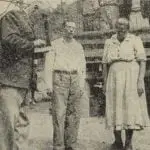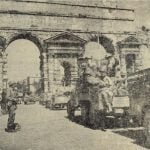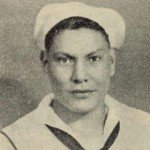
A soldier, who is cited for gallantry in action, when that gallantry does not warrant the award of a Medal of Honor or a Distinguished Service Cross, is given the Silver Star.
This decoration was awarded posthumously to Ben Quintana, a Keres, from Cochiti Pueblo. According to the citation, Ben was “an ammunition carrier in a light machine gun squadron charged with protection of the right flank of his troop which was counterattacked by superior numbers.” The gunner was killed and the assistant gunner severely wounded. “Private Quintana,” the citation continues, “refused to retire from this hazardous position and gallantly rushed forward to the silenced gun and delivered a withering fire into the enemy, inflicting heavy casualties. While so engaged he was mortally wounded. By this extraordinary courage he repulsed the counterattack and prevented the envelopment of the right finks of his troop. Private Quintana’s unflinching devotion to duty and heroism under fire inspired his troop to attack and seize the enemy strong point.”
With Ben Quintana’s death the country has lost one of its most promising young artists. At the age of 15, he won first prize over 80 contestants, of whom 7 were Indians, for a poster to be used in the Coronado Cuarto Centennial celebration. Later, he won first prize and $1,000 in an American Magazine contest in which there were 52,587 entries.
Silver Star to Sherman Graduate
Captain Leonard Lowry, a graduate of Sherman Institute, also wears the Silver Star. He was a first lieutenant at the time of the citation, which says: “He was advancing with an Infantry force of 500 men when they were halted by the enemy and the leading elements were pinned down. It was imperative that this force gets through. Lt. Lowry assumed commend and directed temporary security measures. He then organized a small combat patrol and personally led it in storming the enemy elements that were delaying the Pfc. Ben Quintana, gaffed stalls of Cockloft Pueblo. Awarded the Silver Unit’s advance.” Capt. Lowry has been wounded several times.
Led the way for Tanks
The Shoshones proudly claim Marine Pfc. Leonard A. Webber, of Fort Hall, Idaho, who received his Silver Star “for gallantry and intrepidity while serving with the Second Marine Division, during action against enemy Japanese forces on Tarawa, Gilbert Islands, from November 22 to November 23, 1943. During this period, when radio communication was out, he performed duties as runner between the tank battalion command post, tanks, and infantry front line positions, with utter disregard for his own personal safety in the face of heavy enemy gunfire. His skill and devotion to duty contributed greatly to the maintaining of communication of tank units. His conspicuous gallantry and Intrepidity were In keeping with the highest tradition of the United States Naval Service.”
Later, for action in 1944, Leonard Webber, now Corporal received the Bronze Star, This decoration is awarded for meritorious or receive his Silver Star heroic achievement or service, not involving participation in aerial flight, in connection with military operations against on enemy of the United States. The citation for the Bronze Stare rods:
“For meritorious achievement in action against the enemy on Saipan and Tinian, Merinos Islands, from 15 June to 1 August, 1944, while serving as a reconnaissance man in a Marine tank battalion. With aggressive determination and fearless devotion to duty Corporal Webber reconnoitered routes of advance for tanks in the face of intense enemy fire. On one occasion, he led o tank platoon over exceedingly dangerous and perilous terrain, while under heavy mortar and small arms fire, to support the infantry advance and make it possible for his tank platoon to inflict severe casualties on the enemy. His coo! Courage and outstanding ability contributed in a large measure to the success of the tank operation. His conduct throughout was in keeping with the highest traditions of the United States Navel Service.”
Silver Star for a Cherokee

The mother and father of Pvt. Blaine Queen received the Silver Star posthumously awarded to their son for heroism in action in Germany. Pvt. Queen, a Cherokee from North Carolina, was with a platoon engaged in sharp action with the enemy. They were under heavy fire from nearby enemy positions, and when their ammunition began to run dangerously low, Pvt. Queen volunteered to leave his foxhole and go for the needed supplies. As he ran he was mortally wounded, but in spite of his wound he kept on toward his destination until death overtook him.
A Potawatomi Leads the Way
Pfc. Albert Wahweotten, Pottawatomi from Kansas, received the Silver Star from his commanding general lost February in Germany. According to the citation, Pfc. Wahweotten, armed with an M-1 rifle and a bazooka, worked his way 200 yards beyond the front lines to a house occupied by the enemy. In spite of heavy fire, he crawled to within ten yards of the house, which he set on fire with the bazooka. Then he went into the burning building and captured twelve Germans, eliminating the lost enemy resistance in the town.
Initiative, Bravery and Gallantry
An Iowa Choctaw, also from Kansas, was another winner of the Silver Star for gallantry in action against the Germans. When his superior officer was disabled, Pfc. Thurman E. Nanomantube took over the duties of section leader of a heavy machine gun section, and with complete disregard for his own safety ran across fifty yards of open ground, swept by heavy fire, in order to help a gunner whose gun was not working properly. When the battalion was pinned down by artillery fire, he gave first aid to two wounded men and handled another skillfully in order to keep him from becoming the victim of combat exhaustion. The citation praises Pfc. Nanomantube for his initiative, bravery, and gallantry.
Decoration for a Papago
An engineer’s outfit, in combat for 165 continuous days on Luzon, needed the bulldozer which Pfc. Norris L. Galvez, Papago of Sells, Arizona, was driving up the road. Pfc. Norris was told that the Jap’s had two automatic weapons firing across the rood ahead, but he decided that the bulldozer must go through and unhesitatingly drove the unprotected machine through the field of fire, on action, which brought him a citation and the Silver Star.
Hero’s Son Receives Medal
Alec Hodge is only six years old, but he knows what war means. He knows, too, the pride with which soldiers receive their medals, for on Alec’s small chest was recently pinned the Bronze Star posthumously awarded to his father, Pfc. Otto Hodge, Yurok-Hoopa, who was killed in action In Italy. The youngster stood straight, as befits the son of a warrior, and listened to the words of the citation: “For heroic achievement in action against the enemy from September 10 to September 23, 1944.”
Then he solemnly shook the proffered hand of Brigadier General Oscar B. Abbott, who mode the award. The ceremony was held at the Areata Naval Auxiliary Air Station near Eureka, California, on April 6, 1945.
Alec has two uncles in the service. One, Fireman Henry Hodge, is on sea duty in the South Pacific, while the other, Pvt. James Hodge, is serving in Europe, Both uncles are graduates of Sherman Institute and are the sons of Mrs. Carrie Hodge of Trinidad, California.
Ordeal by Fire
The citation accompanying the Bronze Star Medal awarded to Pvt. Houston Stevens, Kickapoo from Shawnee, Oklahoma, reads:
“For heroic achievement near St. Raphael, France, on 1 5 August 1 944. Struck by an aerial bomb as it neared share during the invasion of Southern France, LST 282 was burning fiercely and ammunition aboard was exploding continuously. Unmindful of the intense heat and the exploding ammunition, Pvt. Stevens manned a 50-caliber machine gun located within ten yards of the explosion. Though the spreading flames singed his hair and eyebrows, he remained at his post and con-fined to fire the gun at the enemy plane. By his devotion to duty, Pvt. Stevens prevented additional damage by the plane. His action reflects credit upon himself and the armed forces of the United States.”
With the Famous Ivy Leaf

Sgt. Perry Skenandore, Oneida from Wisconsin, wears two rows of ribbons, as well as the blue bar for the Presidential Unit Citation. He has been awarded the Silver Star, the Bronze Star with oak leaf cluster, and the Soldier’s Medal. His European theater ribbon carries three bottle stars and the bronze arrow, which stands for the invasion of Normandy. Sgt. Skenandore is a member of the 4th Infantry Division, the Ivy Leaf, a fighting outfit that is described by a Stars and Stripes correspondent as follows:
“After 199 days, ending March 9, in continuous contact with the German army, the 4th Division closed o chapter that carried it through some of the most famous battles of the present war.
“Starting on August 24 with the headlong rush into Paris, which they liberated the next day, the 4th’s men never lost sight of the gray uniformed Wehrmacht until they had it on the run towards the Rhine.
“Included in the nearly seven months of grinding up Nazi hordes were the mad dash across Northern France and Belgium; the liberation or such towns as Chaney, St. Quentin, St, Hubert, Bastogne, and St. Vita, The dough’s never stopped their eastward drive until they had bowled through the Siegfried Line. The 4th Division was the first unit to enter German soil on September 11.
“History has recorded their successful but bloody Bottle of the Huertgen Forest and their magnificent stand before the city of Luxembourg in those dark days of December, when, according to Lt. Gen. George Patton, Jr., tired division halted the left shoulder of the German thrust into the American lines and saved the city of Luxembourg.’
“From this action the Ivy Leaf Division went over to the offensive, crossing the Sure River and eating into the bulge the enemy had built up. Switching to the St. Vith sector, they fought their way through the Siegfried Line in exactly the same place where they had pushed through in September. This mode four times they had passed through the maze of steel and concrete that was once considered almost impregnable.”
Sgt. Skenandore has a good deal to tell about his division and its accomplishments against the Nazis, but little information about himself. The ribbons, however, speak for him.
Held the Lines
The Bronze Star Medal was awarded to Corporal Calvin Flying Bye, Sioux, of Little Eagle, South Dakota, “for heroic achievement in Germany on 29 and 30 November 1944. During these two days, when his division attacked a fortified enemy town,
Communications lines between the forward observer and his battalion were severed. In spite of heavy enemy fire, which was falling not mare than 15 yards from him, he checked the lines and constantly maintained them without getting any sleep for 48 hours. His courage and devotion to duty reflect great credit upon himself and the military service.”
An Alaskan Scores
Pfc. Herbert Bremner, Tlingit, of Yakutat, Alaska, has been given the Bronze Star for heroic action in Holland.
“While the Anti-Tank Platoon which was supporting the assault battalion was moving its weapons forward to engage four enemy tanks which were holding up the progress of the battalion, two of the prime movers were damaged by intense mortar and machine gun fire, and it was necessary to repair them before they could be used to move the weapons into position without regard, for his personal safety. Private Bremner manned the machine gun, which was in an exposed position on top of one of the vehicles. His determined, accurate fire forced the enemy tanks to withdraw, thus permitting the battalion to advance to its objective. The high standard of courage of Private Bremner was a large factor in enabling the battalion to gain its objective and is a distinct credit to this soldier and the military service.”
Inspired His Comrades
Marion W. McKeever, Flathead, from Montana, was awarded the Bronze Star posthumously “for meritorious achievement in connection with military operations against the enemy at Bougainvillea, Solomon Islands, on March 10, 1944. During a counterattack to destroy the enemy forces, when his platoon mode on advance against enemy positions, Pvt. McKeever moved up aggressively to engage the enemy. Moving up as for as possible he crossed a machine gun lone and the enemy opened fire, killing him instantly. Because of his daring movement in spite of the heavy fire, he was one of the most forward men of the platoon. His action was cool and brave and was an inspiration to all who served with him.”
The Bronze Star for Infantryman
A posthumous award of the Bronze Star Medal was made to Cpl. Jock E. Mattz, Yurok-Smith River Indian from Grants Pass, Oregon. During on assault on enemy lines in Holland, Cpl. Mattz crept forward toward o dugout containing a large number of the enemy, killed several of them with his sub-machine gun, and when his ammunition ran out, accounted for the rest by using hand grenades. A few hours later he was killed by shellfire.
Saved by Partisans
Two Indian gunners with the 15th Air Force, based in Italy, had similar stories to tell of parachute jumps in Bolton territory. S-Sgt. Cornelius Wakolee, Potawatomi, from Kansas, was forced to boil out over Yugoslavia when his Liberator bomber was hit by heavy flak. He was reported missing on October 14, and returned to duty some six weeks later, after a long walk, guided across enemy held territory by Yugoslav partisans. Some month’s afterward, T-Sgt. Ray Gonyea, from the Onondaga Reservation, New York, made a similar jump and landed in a village held by the partisans, who helped him and his crew back to their base — after a hilarious celebration. Sgt. Gonyea holds the Air Medal with two oak leaf clusters, and the Purple Heart. Sgt. Wakolee has three clusters to the Air Medal.
Purple Heart, Four Clusters
Danny B. Marshall, Creek, from Holdenville, Oklahoma, has evaded death dozens of times and has been wounded eight times. Five of his wounds required hospital treatment, but the other three times he had first aid and did not report at a hospital. He has been hit in the face, head, arms, leg, and bock, and has the Purple Heart with four clusters, the Bronze Star, the Good Conduct medal, the Combat Infantryman’s Badge, and five battle stars for service in Italy, including the Anzio beach-head and Rome, and the invasion of Southern France.
A Submarine Veteran

“The greatest thrill of all,” said John Redday, Sioux, from South Dakota, “was to pass through the Golden Gate and set foot again on American soil.” This remark was made after 21 months’ service in a submarine patrolling South Pacific waters. During this time the sub sank fourteen and damaged seven enemy vessels. Among them was one of Japan’s largest freighters, which was destroyed by gunfire alone.
The thrills and dangers of submarine warfare were many, according to Redday. Once a sub chaser, disguised as a transport, discovered them while they were surfaced, and depth charges fell all around them before they could submerge. The charges were so terrific that the overhead motors were sheared off. Another time an enemy destroyer caught their prop guard with a grappling iron and pulled them forty feet toward the surface before they could get away. In escaping they dived for below normal depth end the pressure was so great that water leaked in from oil sides.
Redday was transferred to the Veterans’ Hospital at Minneapolis a year ago because of Tuberculosis, and is slowly improving in the free air of his homeland.
A Navajo Fights on Two Fronts
Dragging one wounded soldier, helping support another, his own bock and legs torn by shrapnel, a twenty year old Navajo made his way across three hundred yards of knee-deep snow. Safe in his own lines again, he did not bother to go to the aid station. This is only one of the stories told about Sgt. Clifford Etsitty, a star patrol scout of the Western front. Another time he was within 30 yards of the enemy when a machine gun opened up on his patrol. “The Chief,” as he is known in the Army, flattened out and with six shots finished the half-dozen Nazis who barred his way.
Etsitty received his first Purple Heart on Attu, where he killed 40 Jap’s in 20 days. This was night ambush detail. Clad in white snowsuits, the soldiers lay in wait for enemies and picked them off as they approached. The cold, dangerous work ended when a bursting mortar shell smashed the Navajo’s jaw and sent him to the hospital for seven months. As soon as he was discharged, he was sent to the 99th Division and continued his remarkable career on the German front.
Foresight and Sound Decision
Staff Sgt. David E. Kenote, Wisconsin Menominee, has also received the Bronze Star “for meritorious service in connection with military operations against an enemy of the United States, in France, from 1 August 1944 to 31 October 1944. Sgt. Kenote inaugurated a system of stock records and a procedure for requisitioning which enabled the Adjutant General, Third United States Army, successfully to supply and distribute War Department publications and blank forms to Third Army troops. The foresight of this non-commissioned officer, and his careful planning and energetic execution achieved continuous supply during all phases of o rapidly moving operation. His patience were simple and workable, And his decisions were sound. The zealous devotion to duty’, of Sgt. Kenote reflects great credit upon himself and the military forces of the United States.”
